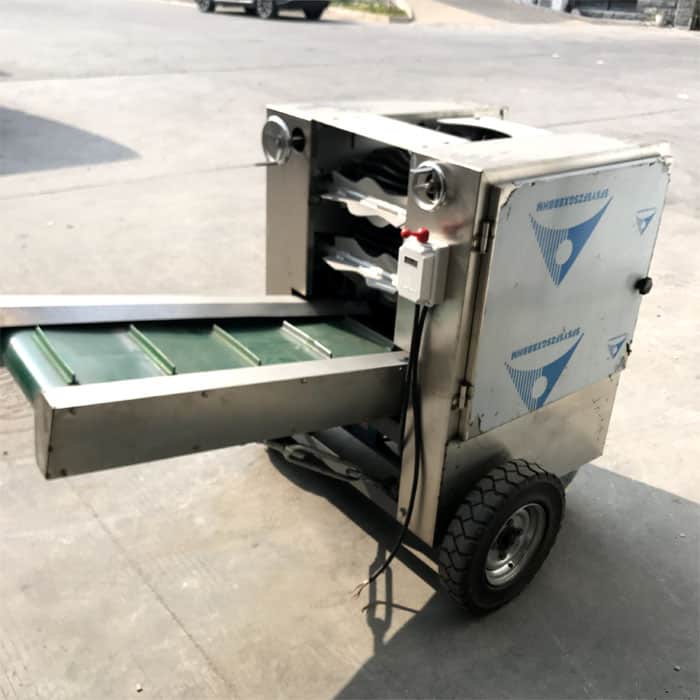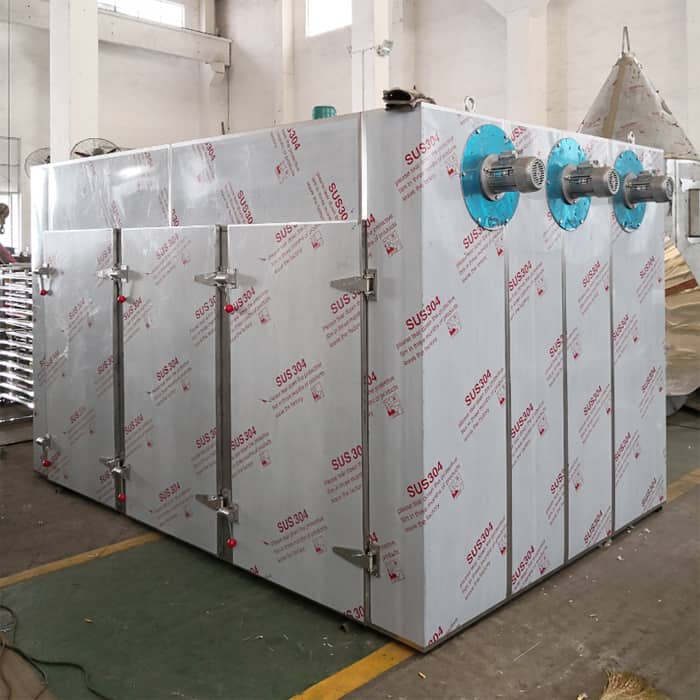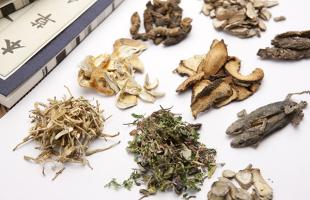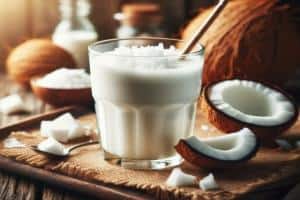Table of Contents
Coconut powder overview
Coconut, as one of the largest drupe fruits, is rich in nutrients and has a sweet and delicious taste. In recent years, with the development of coconut processing technology, virgin coconut oil (VCO), coconut juice, coconut sugar, coconut milk powder, coconut egg white, coconut flakes etc. more and more coconut products are appearing in the market and are widely welcomed by people. This article, we will focus on coconut powder.
So, what is coconut powder?
It is a powder made from dried and grated coconut meat. It retains the natural flavors and nutrients of the coconut, making it a convenient and healthy substitute for fresh coconut, coconut milk, cream, or flour in various recipes.

What’s the benefits of coconut powder?
100 G Coconut powder nutritional composition table
| Nutrients | Qty |
|---|---|
| Calories | 604 |
| Protein | 5.6g |
| Fat | 62g |
| Carbohydrate | 6.4g |
| Energy | 2492Kj |
| SFA | 53.4g |
| MUFA | 3.5g |
| PUFA | 1.5g |
| Sugar | 6.4g |
| Dietary fiber | 13.7g |
First, Coconut powder is a high-quality source of dietary fiber, which is crucial for the health of the digestive system. The fat is mainly medium chain fatty acids (MCTs), are more easily absorbed and utilized by the body, and can quickly provide energy.
Besides, Coconut powder is rich in various vitamins and minerals, including vitamins C, E, B vitamins, iron, magnesium, potassium, antioxidants etc. These nutrients play an important role in maintaining the immune system, promoting energy metabolism, maintaining heart and bone health.
Furthermore, it is low in sugar and calories, it is an excellent choice for people who are trying to lose weight.
The most important benefits of coconut powder is its long shelf life. Unlike fresh coconut, coconut milk or coconut meat, coconut powder can be stored for a year. This makes it a convenient for those who enjoy the flavor of coconut but do not always have access to fresh coconuts.
How to make coconut powder?
Making coconut powder process mainly includes:
coconut husker – coconut shell remover – coconut peeler – coconut meat washing cleaning – coconut slicer – coconut dehydrator – coconut powder grinder – powder filler
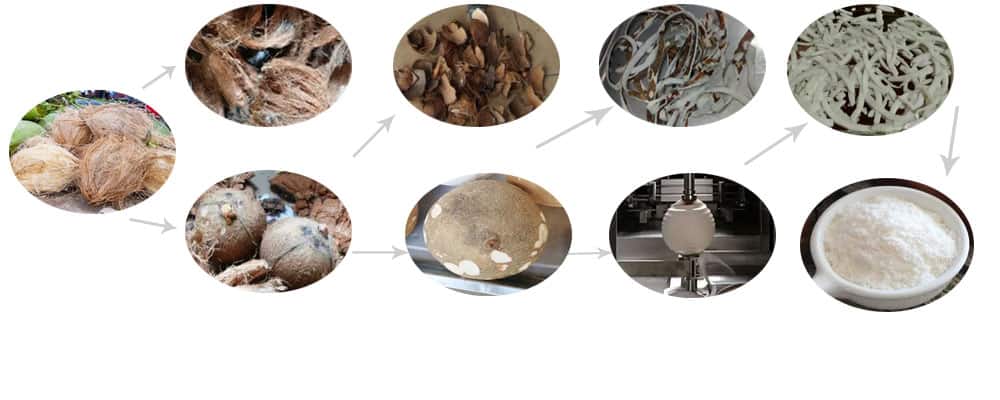
1 . Coconut powder making step 1 — Coconut husk remover
Coconut husk, also known as coconut coir, is the fibrous material found between the hard, internal shell and the outer coat of the coconut. The coconut husk fiber can be processed into coconut husk brick, coconut husk decking, while the byproducts coconut peat can be processed into organic fertilizer.
How to remove coconut from husk?
Manually, chop with a knife, flatten both ends of the head and tail, just enough to hit the hard shell. Novice should slowly chop and not chop too much at once.
Automatically, the coconut husker can remove the coconut husk fiber fast of speed 720pcs/h without harm coconut meat. The old coconut enters the machine and goes through a specially designed palm stripping roller to allow the coconut to fall off. The husked coconut is transported to one side by the material conveyor belt, and the stripped coconuts husk are pulled out by the stripping knife.
2. Coconut powder making step 2 — Coconut shell remover
After removing the outer husk fiber, you will see the coconut shell. The brown hard shell can be used to make coconut shell charcoal, biomass pellets fuels, organic fertilizers, coconut shell handicrafts etc.
How to remove coconut shell?
Automatic coconut shell remover is suitable for removing the shell of coconut after husking. The machine has the characteristics of simple structure, convenient operation, and high efficiency. Can shell 500-1000pcs coconuts per hour.
3. Coconut powder making step 3- coconut peeler
Coconut that is not peeled has a slightly rough taste because the peel is a fibrous texture. Peeled coconut is usually sweeter, has a softer and more tender taste, and is particularly suitable for raw or processed food.
How to peel coconut?
Use a coconut peeler to remove the brown skin from the white flesh. It can peel 500-1000pcs coconut per hour. Not limited by coconut size or height, the peeling thickness can be adjusted. When operating, click on the touch screen, set parameters, put the coconut into the fruit holder, and the machine will automatically complete the separation of picking, feeding, peeling, and discharging.
Then rinse the coconut meat under cold water to remove any residual skin or impurity.
4. Coconut powder making step 4- coconut slicer
Slice coconut into 1-2mm, for fast drying。
5. Coconut dehydrator
After cleaning the copra, it’s time to drying coconut. You have a couple of options. You can either use a food dehydrator or simply dry the coconut meat in the sun. If you are using a food dehydrator, spread the coconut slice on the trays and put into the food dehydrator. The drying temperature should be controlled at 45-60 ℃, which can gradually increase and be dried until the moisture content of the coconut slices is below 8%. The dried coconut slices are white and uniform, with a unique aroma and sweetness of coconut meat.
6. Coconut powder grinder
After the coconut meat is completely dry, it’s time to grind it into powder. Use a multi function powder grinder to process the dried coconut meat to a fine powder. You can choose different mesh sieve from 10mesh to 200mesh according to your fineness requirement. For finer 200-350mesh, you can use ultra fine powder grinder machine.
7. Powder filler
Once the coconut meat has been processed into a fine powder, it’s ready to be stored. Using powder filler to filling the coconut powder to an airtight container or packaging into bags. Properly stored coconut powder can last for several to 12 months, maintaining its freshness and flavor.
Machines for making coconut powder
How to use coconut powder?
- Directly drinking: one of the simplest ways to use coconut powder is to reconstitute it with water to make coconut milk. It is a cost-effective and convenient substitude for canned coconut milk.
- Cooking: it can also be used as a seasoning to marinades and sauces. Simply mix it with other spices and liquids to create a flavorful paste that can be used to marinate meat, poultry, or seafood before grilling or roasting.Or use it as a thickening agent to add a subtle coconut flavor to a dish, soups, stews, and sauce.
- In baking: it can be used as a substitute for desiccated coconut. Add it to bread, cake, and cookies can enhance the coconut aroma and taste.
- Dessert: It can be used to make coconut-flavored yogurt or ice cream.
- Skin care and beauty: It can be used as a base for homemade lotions and hair masks, or simply added to existing beauty products for an extra boost of hydration.
Overall, coconut powder is a convenient and nutritious ingredient that can be used in a wide range of recipes. Its long shelf life, versatility, and health benefits make it increasingly popular. The coconut industry has a very broad market prospect and is expected to become a rapidly growing industry in the future.

